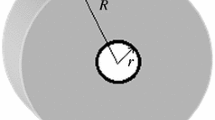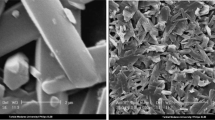Abstract
The pre-cracked Brazilian disc specimens of rock-like materials (Portland Pozzolana cement (PPC), fine sands, and water) are especially prepared in a rock mechanics laboratory to study the breaking process of brittle solids. The Brazilian discs may contain one, two, three, four, and five (parallel) center slant cracks (45° to the horizontal) under compressive line loading. The breaking load of the pre-cracked disc specimens is measured showing that as the number of cracks increases, the final breakage load of the specimen decreases. The experiments are carried out under compression (just like the Brazilian tests used for measuring the indirect tensile strength of intact rocks). It has been experimentally observed that the wing cracks are produced at the first stage of loading and start their propagation toward the direction of compressive line loading in the pre-cracked Brazilian discs. The same specimens are numerically simulated by a higher order displacement discontinuity method (HDDM). The effect of bridge area and orientation of cracks on the cracks coalescence and breakage path of the pre-cracked Brazilian discs specimens are simultaneously studied.












Similar content being viewed by others
References
Aliabadi MH, Rooke DP (1991) Numerical fracture mechanics. Computational Mechanics Publications, Southampton, U.K
Al-Shayea NA (2005) Crack propagation trajectories for rocks under mixed mode I–II fracture. Eng Geol 81:84–97
Al-Shayea NA, Khan K, Abduljauwad SN (2000) Effects of confining pressure and temperature on mixed-mode (I–II) fracture toughness of a limestone rock formation. Int J Rock Mech Rock Eng 37:629–643
Atkinson C, Smelser RE, Sanchez J (1982) Combined mode fracture via the cracked Brazilian disk. Int J Fract 18:279–291
Ayatollahi MR, Aliha MRM (2008) On the use of Brazilian disc specimen for calculating mixed mode I–II fracture toughness of rock materials. Eng Fract Mech 75:4631–4641
Ayatollahi MR, Sistaninia M (2011) Mode II fracture study of rocks using Brazilian disk specimens. Int J Rock Mech Min Sci 48:819–826
Awaji H, Sato S (1978) Combined mode fracture toughness measurement by the disk test. J Eng Mater Technol 100:175–182
Bobet A, Einstein HH (1998) Fracture coalescence in rock-type materials under uniaxial and biaxial compression. Int J Rock Mech Min Sci 35:863–888
Chen JT, Hong HK (1996) Dual boundary integral equations for exterior problems. Eng Anal Boun Elem 16:333–340
Chen JT, Wong FC (1997) Analytical derivations for one-dimensional Eigen problems using dual BEM and MRM. Eng Anal Bound Elem 20:25–33
Chen JT, Hong HK (1999) Review of dual boundary element methods with emphasis on hyper singular integrals and divergent series. Appl Mech Rev Asme 52:17–33
Cheng-zhi P, Ping C (2012) Failure characteristics and its influencing factors of rock-like material with multi-fissures under uniaxial compression. Trans Nonferrous Metals Soc China 22:185–191
Crouch SL (1967) Analysis of stresses and displacements around underground excavations: an application of the displacement discontinuity method. University of Minnesota Geomechanics Report, Minnesota
Crouch SL, Starfield AM (1983) Boundary element methods in solid mechanics. Allen and Unwin, London
Dai F, Chen R, Iqbal MJ, Xia K (2010) Dynamic cracked chevron notched Brazilian disc method for measuring rock fracture parameters. Int J Rock Mech Min Sci 47:606–613
Dai F, Xia K, Zheng H, Wang YX (2011) Determination of dynamic rock mode-I fracture parameters using cracked chevron notched semi-circular bend specimen. Eng Fract Mech 78:2633–2644
Erdogan F, Sih GC (1963) On the crack extension in plates under loading and transverse shear. J Fluids Eng 85:519–527
Funatsu T, Kuruppu M, Matsui K (2014) Effects of temperature and confining pressure on mixed mode (I–II) and mode II fracture toughness of Kimachi sandstone. Int J Rock Mech Min Sci 67:1–8
Ghazvinian A, Nejati HR, Sarfarazi V, Hadei MR (2013) Mixed mode crack propagation in low brittle rock-like materials. Arab J Geosci 6:4435–4444
Guo H, Aziz NI, Schmidt RA (1990) Linear elastic crack tip modeling by displacement discontinuity method. Eng Fract Mech 36:933–943
Haeri H, Shahriar K, Marji MF, Moaref Vand P (2013a) A coupled numerical-experimental study of the breakage process of brittle substances. ArabJ geosci Pres, Accpt Manuscr. doi:10.1007/s12517–013–1165–1
Haeri H, Shahriar K, Marji M F, Moaref Vand P (2013b) Modeling the propagation mechanism of two random micro cracks in rock samples under uniform tensile loading. In: Proceedings of 13th International Conference on Fracture, China
Haeri H, Shahriar K, Marji MF, Moaref Vand P (2014a) On the strength and crack propagation process of the pre-cracked rock-like specimens under uniaxial compression. strength mater 46:171–185
Haeri H, Shahriar K, Marji MF, Moaref Vand P (2014b) An experimental and numerical study of crack propagation and cracks coalescence in the pre-cracked rock-like disc specimens under compression. int j rock Mecha Min sci 67c:20–28
Haeri H, Shahriar K, Marji MF, Moaref Vand P (2014c) On the HDD analysis of micro cracks initiation, propagation and coalescence in brittle substances. Arab J Geosc Pres Accept Manuscr. doi:10.1007/s12517-014-1290-5
Haeri H, Shahriar K, Fatehi Marji M, Moarefvand P (2014d) On the crack propagation analysis of rock like Brazilian disc specimens containing cracks under compressive line loading. lat amer J solids struct 11:400–1416
Haeri H, Marji MF, Shahriar K (2014e) Simulating the effect of disc erosion in TBM disc cutters by a semi-infinite DDM. Arab J geosc Pres, Accept Manus. doi:10.1007/s12517–014–1489–5
Hoek E, Bieniawski ZT (1965) Brittle rock fracture propagation in rock under compression, South African Council for Scientific and Industrial Research Pretoria. Int J Fract Mech 1:137–155
Hong HK, Chen JT (1988a) Generality and special cases of dual integral equations of elasticity. J Chinese Society Mech Eng 9:1–9
Hong HK, Chen JT (1988b) Derivation of integral equations of elasticity. J Eng Mech, ASCE 114(6):1028–1044
Horii H, Nemat-Nasser S (1985) Compression-induced micro crack growth in brittle solids: axial splitting and shear failure. J Geophys Res 90:3105–3125
Huang JF, Chen GL, Zhao YH, Wang R (1990) An experimental study of the strain field development prior to failure of a marble plate under compression. Tectonophysics 175:269–284
Hussian M A, Pu E L, Underwood J H (1974) Strain energy release rate for a crack under combined mode I and mode II. In: Fracture analysis. ASTM STP 560. American Society for Testing and Materials, pp 2–28
Ingraffea A R (1985) Fracture propagation in rock, Mechanics of Geomaterials 219–258
Irwin GR (1957) Analysis of stress and strains near the end of a crack. J Appl Mech 24:361
Janeiro RP, Einstein HH (2010) Experimental study of the cracking behavior of specimens containing inclusions (under uniaxial compression). Int J Fract 164:83–102
Kato T, Nishioka T (2005) Analysis of micro-macro material properties and mechanical effects of damaged material containing periodically distributed elliptical microcracks. Int J Fract 131:247–266
Khan K, Al-Shayea NA (2000) Effects of specimen geometry and testing method on mixed-mode I–II fracture toughness of a limestone rock from Saudi Arabia. Rock Mech Rock Eng 33:179–206
Krishnan GR, Zhao XL, Zaman M, Rogiers JC (1998) Fracture toughness of a soft sandstone. Int J Fract Mech 35:195–218
Lee H, Jeon S (2011) An experimental and numerical study of fracture coalescence in pre-cracked specimens under uniaxial compression. Int J Solids Struct 48:979–999
Li YP, Chen LZ, Wang YH (2005) Experimental research on pre-cracked marble under compression. Int J Solids Struct 42:2505–2516
Manouchehrian A, Sharifzadeh M, Marji MF, Gholamnejad J (2014) A bonded particle model for analysis of the flaw orientation effect on crack propagation mechanism in brittle materials under compression. Arch Civ Mech Eng 14:40–52
Marji MF, Hosseinin_Nasa H, Kohsary AH (2006) On the uses of special crack tip elements in numerical rock fracture mechanics. Int J Solids Struct 43:1669–1692
Marji MF (1997) Modeling of cracks in rock fragmentation with a higher order displacement discontinuity method. Ph.D. Thesis, Middle East Technical University. Turkey, Ankara
Marji MF (2013) On the use of power series solution method in the crack analysis of brittle materials by indirect boundary element method. Eng Fract Mech 98:365–382
Marji MF, Dehghani I (2010) Kinked crack analysis by a hybridized boundary element/boundary collocation method. Int J Solids Struct 47:922–933
Mohtarami E, Jafari A, Amini M (2014) Stability analysis of slopes against combined circular-toppling failure. Int J Rock Mech Min Sci 67:43–56
Park CH (2008) Coalescence of frictional fractures in rock materials. PhD Thesis. Purdue University West Lafayette, Indiana
Park CH, Bobet A (2006) The initiation of slip on frictional fractures. Golden Rocks, ARMA/USRMS, pp 06–923
Park CH, Bobet A (2009) Crack coalescence in specimens with open and closed flaws: a comparison. Int J Rock Mech Min Sci 46:819–829C
Park CH, Bobet A (2010) Crack initiation, propagation and coalescence from frictional flaws in uniaxial compression. Engin Fract Mech 77:2727–2748
Sahouryeh E, Dyskin AV, Germanovich LN (2002) Crack growth under biaxial compression. Eng Fract Mech 69:2187–2198
Sanchez J (1979) Application of the disk test to mode-I–II fracture toughness analysis, M.S. Thesis. Department of Mechanical Engineering. University of Pittsburgh, Pittsburgh, U.S.A
Scavia C (1990) Fracture mechanics approach to stability analysis of crack slopes. Eng Fract Mech 35:889–910
Shen B, Stephansson O (1994) Modification of the G-criterion for crack propagation subjected to compression. Eng Fract Mech 47:177–189
Shen B, Stephansson O, Einstein HH, Ghahreman B (1995) Coalescence of fractures under shear stress experiments. J Geophy Res 100:5975–5990
Shou KJ (1997a) A higher order displacement discontinuity method for three-dimensional elastostatic problems. Int J Rock Mech Min Sci Geomech Abstr (SCI) 34(2):317–322
Shou KJ (1997b) A two-dimensional displacement discontinuity method for multi-layered elastic media. Int J Rock Mech Min Sci Geomech Abstr (SCI) 34(3–4):509
Shou KJ (1999) A hybrid boundary element method for the analysis of a tunnel penetrating a weak plane. Chinese J Rock Mech Eng (EI) 894–901
Shou KJ (2000a) A novel superposition scheme to obtain fundamental boundary element solutions in multi-layered elastic media. Inter J Numeri Analyt Methods Geomech 24(10):795–814
Shou KJ (2000b) A three-dimensional hybrid boundary element method for non-linear analysis of a weak plane near an underground excavation. InterJ Tunnel Under Space Techn 15(2):215–226
Shou KJ (2006) Boundary element analysis of tunneling through a weak zone. J Geomech (EI) 1(1):25–28
Shou KJ, Crouch SL (1995) A higher order displacement discontinuity method for analysis of crack problems. Int J Rock Mech Min Sci Geomech Abstr 32:49–55
Shetty DK, Rosenfield AR, Duckworth WH (1986) Mixed mode fracture of ceramic in diametrical compression. J Am Ceram Soc 69:437–443
Sih GC (1974) Strain-energy-density factor applied to mixed mode crack problems. Int J Fract 10:305–321
Wang QZ (2010) Formula for calculating the critical stress intensity factor in rock fracture toughness tests using cracked chevron notched Brazilian disc (CCNBD) specimens. Int J Rock Mech Min Sci 47:1006–1011
Wang QZ, Feng F, Ni M, Gou XP (2011) Measurement of mode I and mode II rock dynamic fracture toughness with cracked straight through flattened Brazilian disc impacted by split Hopkinson pressure bar. Eng Fract Mech 78:2455–2469
Wang QZ, Gou XP, Fan H (2012) The minimum dimensionless stress intensity factor and its upper bound for CCNBD fracture toughness specimen analyzed with straight through crack assumption. Eng Fract Mech 82:1–8
Wong RHC, Chau KT (1998) Crack coalescence in a rock-like material containing two cracks. Int J Rock Mech Min Scie 35:147–164
Wong RHC, Chau KT, Tang CA, Lin P (2001) Analysis of crack coalescence in rock-like materials containing three flaws—part I: experimental approach. Int J Rock Mech Min Scie 38:909–924
Wong LNY, Li HQ (2013) Numerical study on coalescence of two pre-existing coplanar flaws in rock. Int J Solids Struct 50:3,685–3,706
Wong RHC, Tang CA, Chau KT, Lin P (2002) Splitting failure in brittle rocks containing pre-existing flaws under uniaxial compression. Engin Frac Mecha 69:1,853–1,871
Yang SQ (2011) Crack coalescence behavior of brittle sandstone samples containing two coplanar fissures in the process of deformation failure. Engin Fract Mech 78:3,059–3,081
Yang Q, Dai YH, Han LJ, Jin ZQ (2009) Experimental study on mechanical behavior of brittle marble samples containing different flaws under uniaxial compression. Engin Fract Mech 76:1,833–1845S
Author information
Authors and Affiliations
Corresponding author
Rights and permissions
About this article
Cite this article
Haeri, H., Khaloo, A. & Marji, M.F. Experimental and numerical analysis of Brazilian discs with multiple parallel cracks. Arab J Geosci 8, 5897–5908 (2015). https://doi.org/10.1007/s12517-014-1598-1
Received:
Accepted:
Published:
Issue Date:
DOI: https://doi.org/10.1007/s12517-014-1598-1




